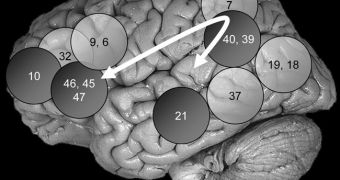We do not possess a memory center: this ability is spread over most of the brain areas. A new review made by Richard Haier of the University of California, Irvine and Rex Jung of the University of New Mexico on 37 imaging studies has revealed that human intelligence, too.
"Genetic research has demonstrated that intelligence levels can be inherited, and since genes work through biology, there must be a biological basis for intelligence," Haier said.
The new review shows that intelligence is not so much linked to the brain size or a particular brain nucleus, but to the effectiveness of the information traveling through the brain.
"Our review of imaging studies identifies the stations along the routes intelligence information processing takes. Once we know where the stations are, we can study how they relate to intelligence." said Haier.
The authors focused on those brain zones that appeared multiple times in the studies and these pointed out that intelligence is clustered in the frontal and parietal lobes. The same areas are also linked to attention, memory, high complex functions like language and this has a meaning.
The authors come with the Parieto-Frontal Integration Theory (P-FIT) that states intelligence levels are determined by the effectiveness of the communication between these brain zones.
"The new theory sidesteps the sticky question of what intelligence is, something that scientists have yet to agree on. In every single study that we reviewed, there was a different measure of intelligence," said Haier.
"There's controversy about what is the best measure of intelligence. There's controversy over how broad or narrow the definition of intelligence should be. Our work really goes beyond those questions and basically says that irrespective of the definition of intelligence you use in neuroimaging studies, you find a similar result."
"The P-FIT model highlights the progress scientists have made in recent years toward understanding the biological basis of intelligence. 25 years ago researchers in the field were engaged in an unedifying discussion of the relation between skull sizes and intelligence test scores," said Earl Hunt, a neuroscientist at the University of Washington, not involved in this study.
The same team revealed in 2004 that areas linked to general intelligence are spread throughout the brain and there was no unique "intelligence center". In 2005, the same authors showed that even if women possess more white matter (neuronal connections linking brain centers) and men more gray matter (neuronal bodies that process information), there is no significant intelligence difference between the genders. It seems that various types of brain designs can result in similar intellectual performance.
"Knowing what determines intelligence might lead to treatments for diseases of intelligence like mental retardation," Haier said.
"It would be important to now how intelligence works to determine if there's any way to treat low IQ," Haier told LiveScience.
"If you can treat low IQ in mental retardation because you identify something wrong in the brain that's affecting intelligence, then that raises the question of whether you can raise IQ in people that don't necessarily have the brain injuries."

 14 DAY TRIAL //
14 DAY TRIAL //